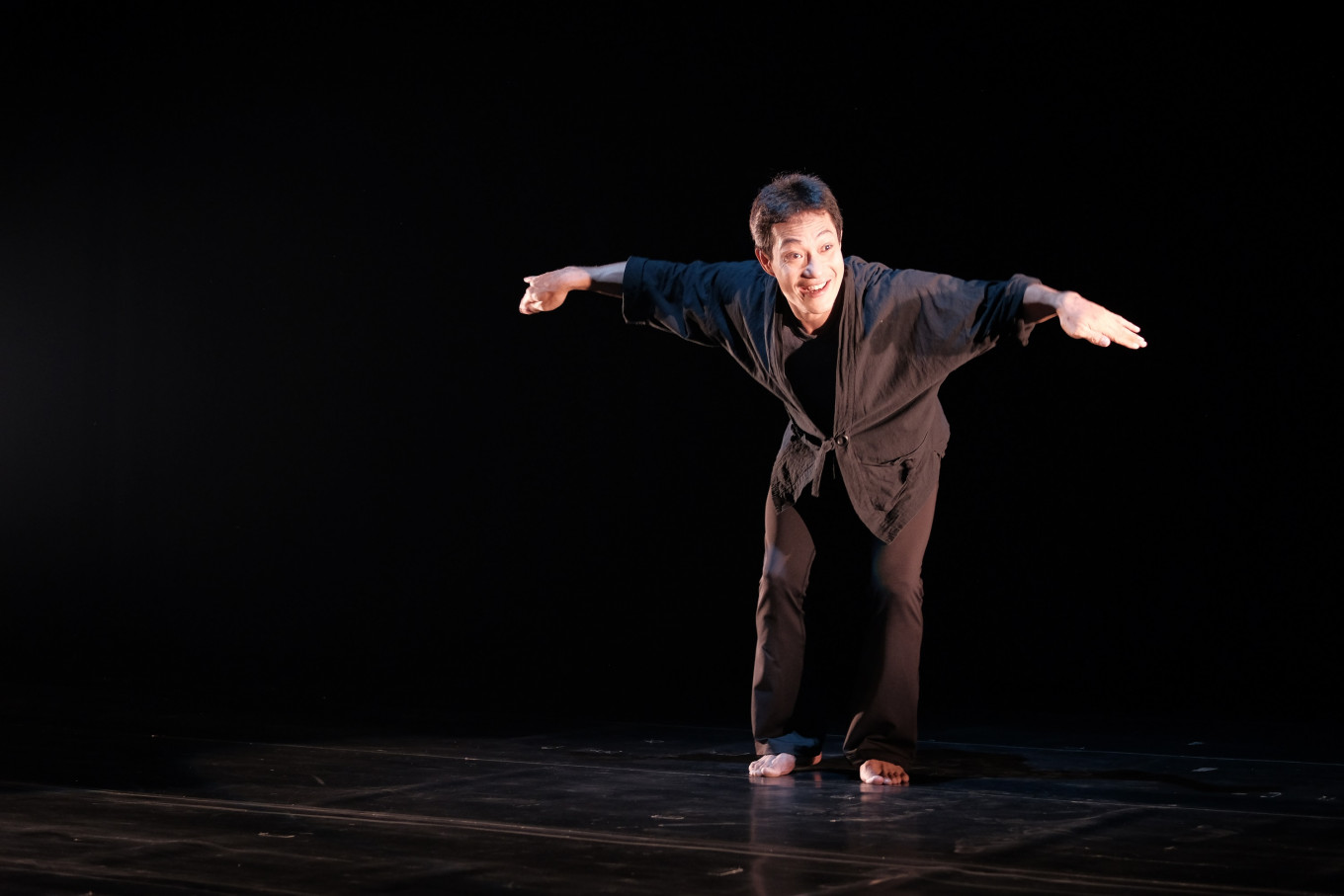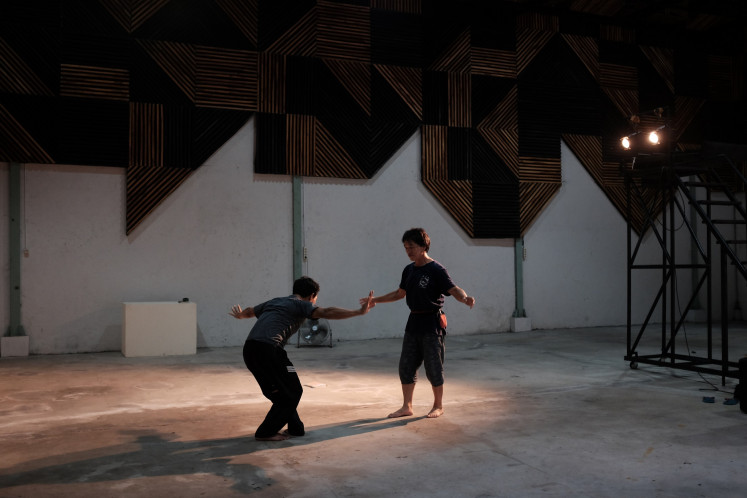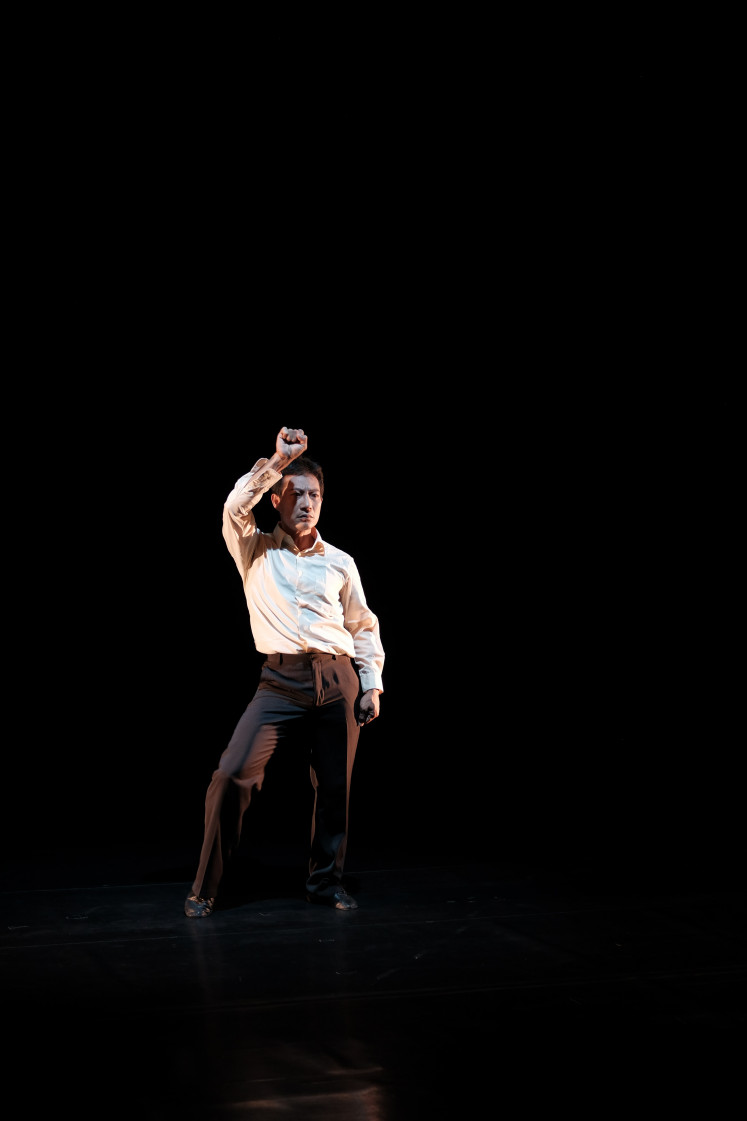Popular Reads
Top Results
Can't find what you're looking for?
View all search resultsPopular Reads
Top Results
Can't find what you're looking for?
View all search results‘Nafas Nafsu’: Pantomime theater transfers emotion via digital stage
Can theater convey emotion and reach audiences through a virtual stage? Mime artist Asita Kaladewa had his initial doubts proven wrong when Padepokan Seni Bagong Kussudiardja uploaded his latest work on YouTube.
Change text size
Gift Premium Articles
to Anyone
 In a void: Mime artist Asita Kaladewa performs in 'Nafas Nafsu' (Breath of Lust) produced by performing arts group Padepokan Seni Bagong Kussudiardja (PSBK), which has put its Jagongan Wagen monthly series on a digital stage during the two-week "stay at home" policy. (Padepokan Seni Bagong Kussudiardja/-)
In a void: Mime artist Asita Kaladewa performs in 'Nafas Nafsu' (Breath of Lust) produced by performing arts group Padepokan Seni Bagong Kussudiardja (PSBK), which has put its Jagongan Wagen monthly series on a digital stage during the two-week "stay at home" policy. (Padepokan Seni Bagong Kussudiardja/-)
A
t a time when everyone is staying home, Padepokan Seni Bagong Kussudiardja (PSBK) has transitioned its monthly shows so it is just one click away.
Founded by the late choreographer and painter Bagong Kussudiardja, PSBK is now streaming its Jagongan Wagen monthly series – except for the Islamic fasting month of Ramadhan – on the the performing arts group's official YouTube channel, Media PSBK.
PSBK’s second show of the 2020 series, which started in February, highlights the art of pantomime with Nafas Nafsu (Breath of Lust).
Pantomime performances are a rarity in Indonesia, and the word would prompt most to think of comical street performers in a black-and-white striped shirt a la Marcel Marceau.
While pantomime theater involves comedic conventions like slapstick and wordplay, some productions take on themes and theatrical interpretations of a more serious nature. Nafas Nafsu is one of these.
Starring in the production is Asita Kaladewa, a Kudus-born mime artist from Central Java and co-founder of Bengkel Mime Theatre.
Dramaturgy and music are the responsibility of Naoki Nagai, a Japanese mime artist who studied at the Tokyo Mime Institute and was a one-time lecturer at Showa Music Academy.
Despite the rather risqué title, Nafas Nafsu is born of Asita’s relationship with nature: on the one hand, the artist's idea of an ideal life was to be one with nature, but on the other, modern life required practical solutions that kept him from nature.
To create Nafas Nafsu, Asita revisited four pieces in his repertoire that explored human beings' relationship with nature – “Berburu Serangga” (Bug Hunting), “Sesak” (Suffocated), “Tanjung Harapan” (Bay of Hope), and “Fish” – and reinterpreted them into four "acts": “Target”, “Fisherman”, “Menunggu” (Waiting) and “Trapped”.
Nafas Nafsu opens with “Target”, with starts relatively simply with hand movements set to cheery instrumental music. Then, the camera zooms out, the music comes to a halt, and Asita proceeds with a more distinct storyline that is apparent through his movements.
The first act, appropriately named, sees Asita aiming at an invisible target, one that he goes to great lengths to shoot. Depending on interpretation, Asita could be either a photographer or a marksman, but this is left ambiguous with the absence of narration.
The second act is “Fisherman”, during which the sound of rolling waves accompanies Asita as he works on an imaginary net. He mimes every aspect of a fisherman’s life on the open seas, from rowing to responding to what could be seagulls circling in the skies above.
“Fisherman” is much calmer and almost transcendental, as viewers can see even the smallest, almost dainty hand movements. Surrounded by darkness, Asita looks for the most part as if he is dancing in the void, interspersed with the interpretive gestures of the fisherman and segments that hint at underwater life.
Act three, “Menunggu”, sees Asita sitting alone on a bench, taking an almost comical persona with Mr. Bean-esque mannerisms and facial expressions, accompanied by jazzy strings.
The storyline is much clearer in this act, with an obvious plot that showcases Asita’s comedic and acting chops as he switches from zany, fast-paced comedy to an almost melancholic tone in close proximity of the lens.
The last of the four acts is “Trapped”, which features a clear caricature of modern-day white-collar workers.
Set to rhythmic tapping, Asita goes through familiar motions from the morning commute, to taking phone calls while typing away, and to going on a lunch break.
“Trapped” is notable for its looping repetitiveness, which might be the whole point. It starts out with what appears to be a good day, with the character happily going about his routine, but the tapping becomes faster with each repeated cycle, while the movements become more frantic.
By the third cycle, Asita seems to portray all us office workers after a certain point in life, just going through the motions robotically. The act ends with a shot of Asita’s clenched fists with the rhythmic tapping increasingly sounding like the ticking of a clock, perhaps signifying that time is running out.
Daily grind: Asita Kaladewa performs in "Trapped", the final act in the four-act 'Nafas Nafsu' that appears to be a commentary on the monotonous routine of modern-day white-collar workers. (Padepokan Seni Bagong Kussudiardja/-)While attending a live show has certain charms that cannot be replicated on video, the COVID-19 pandemic has made it impossible to attend events outside the home.
Still, there are some benefits to watching a streaming performance: you can rewind or replay if you are distracted from the show by something else. The camerawork also serves to highlight specific parts of a scene, making sure that every shot is viewed as the artists intended.
Executive director Jeannie Park of the Bagong Kussudiardja Foundation – the non-profit organization behind PSBK – said that even though it had taken a hit from the pandemic like many other arts groups, the role of the arts in serving humanity was more imperative now than ever before.
“Not only in producing important art that will benefit from the outburst of engagements after a period of social distancing, but a culture that enables society to protect the health and safety of others with compassion, and to build a sustainable future,” Park said in a statement.
The question is whether the essence of the performance can successfully reach the audience, remotely or otherwise.
Asita initially had his own reservations about the change in medium, noting that he had envisioned Nafas Nafsu to be enjoyed in a live theatrical setting so the audience could feel what he felt in the shared environment.
Based on the numbers alone, the show can be hailed as a success, with views well exceeding the 150-seat PSBK theater, at more than 940 for both the closed-caption and unsubtitled versions to date and rising by the day.
As for viewer responses, the comments section is full of nothing but positivity, with many praising PSBK for its initiative as well as Asita’s expressive performance.
“In the journey, the artist’s ego is of course very prominent, so when I heard that the performance would be postponed, I had to start compromising,” Asita remarked.
“Of course it stung a little, but I then questioned why I, in developing this body of work, was able manage my feelings and not in the real world. But it's fine, creativity can still run and it turned out to be an unexpected surprise,” he said.












